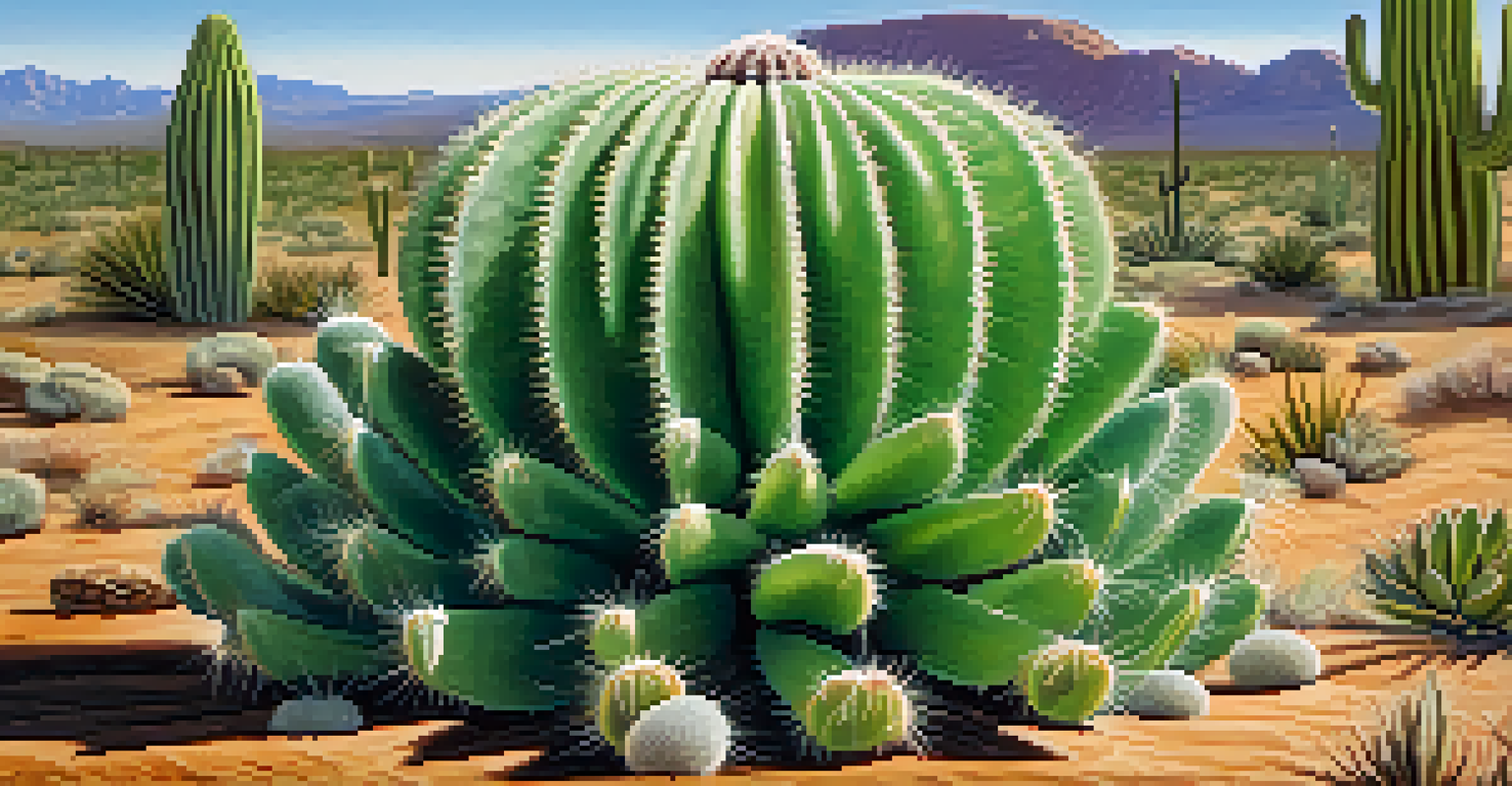Peyote Use in Shamanism: A Comparative Religious Study

Understanding Peyote: A Sacred Cactus
Peyote, a small cactus native to Mexico and the southwestern United States, is revered for its psychoactive properties. Containing mescaline, a natural hallucinogen, peyote has been used for centuries in various spiritual practices. It serves not only as a source of vision and insight but also as a tool for healing and connection with the divine.
The cactus was a sacred medicine, revealing the mysteries of nature and the universe.
In many indigenous cultures, peyote is more than just a plant; it is considered a sacred medicine. Shamanic practitioners often use it to facilitate rituals, connecting with ancestors and spirits. This deep reverence for peyote highlights its role as a bridge between the physical and spiritual realms.
Understanding peyote's significance sets the stage for exploring its diverse applications in shamanism. By examining how different cultures integrate this sacred cactus into their spiritual practices, we can appreciate the rich tapestry of beliefs surrounding it.
Historical Context of Peyote in Shamanism
The use of peyote in shamanism dates back thousands of years, with evidence found in archaeological sites in Mesoamerica. Indigenous tribes, such as the Huichol and the Tarahumara, embraced peyote as a central component of their spiritual traditions. These early practices laid the groundwork for peyote's role in contemporary shamanism.

As colonial influences spread, the perception of peyote began to shift. While some viewed it as a mere curiosity, others recognized its profound spiritual significance. This dichotomy illustrates the complex relationship between traditional practices and external societal pressures.
Peyote's Sacred Role in Cultures
Peyote is revered as a sacred medicine in various indigenous cultures, facilitating spiritual connections and healing.
Despite challenges, the enduring legacy of peyote use among indigenous peoples emphasizes its resilience. Understanding this historical context enriches our appreciation for the ongoing importance of peyote in shamanic practices today.
Peyote in North American Indigenous Cultures
In North America, peyote holds a special place within various indigenous cultures, particularly among Native American tribes. The Native American Church, formed in the early 20th century, incorporates peyote use into its rituals, promoting healing and spiritual connection. This adaptation demonstrates how peyote has evolved while maintaining its traditional significance.
To understand peyote is to understand the heart of indigenous spirituality.
Ceremonies involving peyote often include music, prayers, and communal sharing, reinforcing the sense of community among participants. These gatherings provide a space for individuals to explore their spirituality and seek guidance from the plant's teachings. This communal aspect is central to the transformative experience of peyote use.
Furthermore, the legal recognition of peyote within the Native American Church highlights its importance in modern spiritual practices. By examining these contemporary uses, we gain insight into how peyote continues to shape identity and spirituality among indigenous groups.
Psychoactive Properties and Spiritual Experiences
The psychoactive properties of peyote are what draw many to its use in shamanism. Upon consumption, individuals often experience vivid visual and auditory hallucinations, deep introspection, and a heightened sense of connection to the universe. These experiences can lead to profound insights and healing, making peyote a powerful tool in spiritual journeys.
For shamans, these altered states of consciousness are essential for accessing spiritual realms. They often report communicating with spirits and receiving guidance during peyote ceremonies. This ability to transcend ordinary reality underscores the cactus's role as a facilitator of spiritual exploration.
Historical Significance of Peyote
The use of peyote in shamanism has deep historical roots, shaping spiritual practices among indigenous tribes for thousands of years.
However, the experience of peyote is not solely about visions; it also involves emotional release and healing. Participants often emerge from ceremonies feeling renewed and transformed, highlighting the therapeutic potential of this sacred plant.
Comparative Practices: Peyote vs. Other Entheogens
While peyote is a significant entheogen in shamanism, it is not alone. Other psychoactive substances, such as psilocybin mushrooms and ayahuasca, are also used in spiritual practices worldwide. Each of these substances offers unique experiences and insights, reflecting the diverse approaches to altered states of consciousness across cultures.
For instance, ayahuasca, a brew made from the Amazonian vine and other plants, promotes a deeply introspective journey often accompanied by intense purging. In contrast, peyote ceremonies emphasize communal sharing and connection with nature. This comparison illustrates how different cultures utilize entheogens to achieve similar spiritual goals.
Ultimately, examining the similarities and differences between these practices enriches our understanding of shamanism as a whole. It reveals a collective human desire to explore the depths of consciousness and seek connection with the divine, regardless of the specific substances used.
Contemporary Challenges Facing Peyote Use
Despite its rich history, the use of peyote today faces significant challenges. Overharvesting and habitat loss threaten the cactus's survival, which raises concerns for indigenous communities reliant on it for cultural practices. This environmental crisis highlights the need for sustainable harvesting practices and conservation efforts.
Moreover, as interest in psychedelics grows, the commercialization of peyote poses ethical dilemmas. Many indigenous groups worry that the sacredness of peyote is being diluted by its exploitation in recreational contexts. This tension calls for a respectful dialogue about the cultural significance of peyote and the need to honor its traditional use.
Challenges Facing Peyote Today
Peyote is threatened by overharvesting and commercialization, raising ethical concerns about its sacredness and cultural significance.
Addressing these challenges is crucial for preserving the integrity of peyote use in shamanism. By advocating for indigenous rights and sustainable practices, we can help ensure that this sacred cactus continues to play a vital role in spiritual traditions.
The Future of Peyote in Shamanism
As we look to the future, the role of peyote in shamanism is poised for both change and continuity. While modern challenges abound, there is a growing recognition of the need to respect and preserve indigenous traditions. This shift presents an opportunity for a renewed appreciation of peyote as a sacred medicine.
Collaboration between indigenous communities and broader society is essential for ensuring the survival of peyote traditions. By prioritizing education and awareness, we can foster deeper understanding and respect for the cultural significance of this cactus. This partnership could lead to more sustainable practices and greater appreciation for indigenous wisdom.

Ultimately, the future of peyote in shamanism depends on our collective willingness to honor its legacy. By embracing the lessons learned from traditional practices, we can cultivate a more profound respect for the natural world and the spiritual journeys it offers.